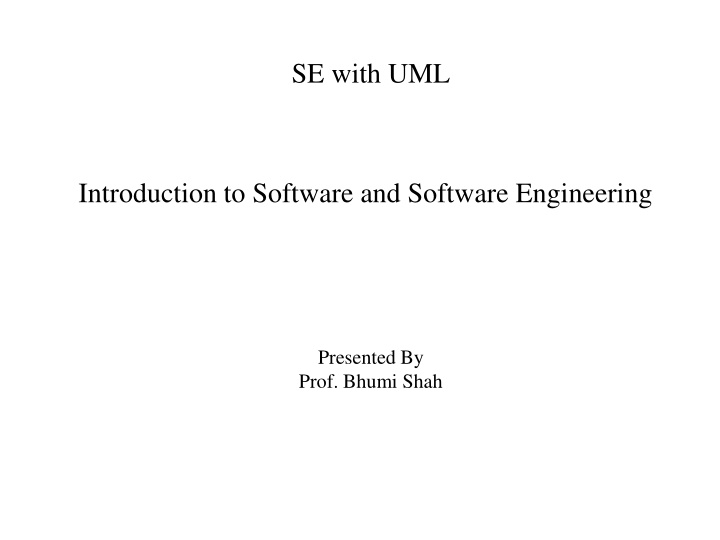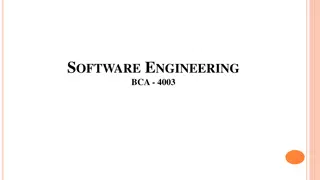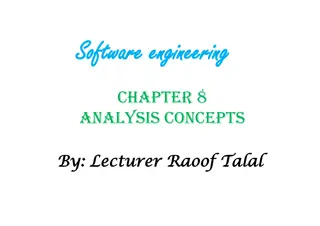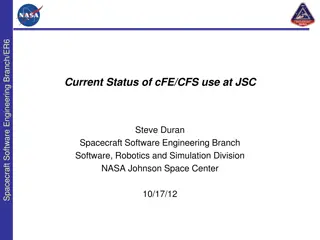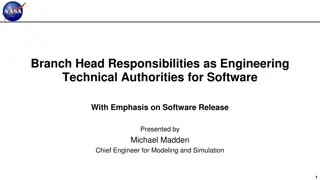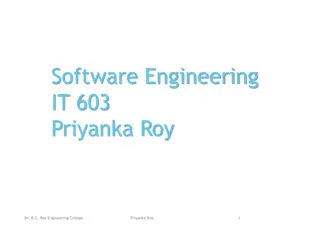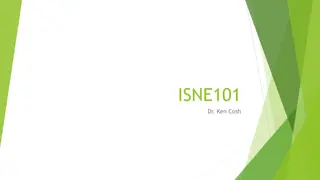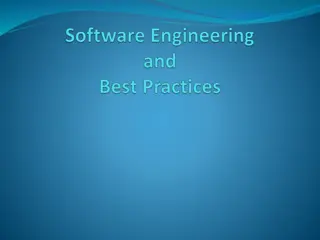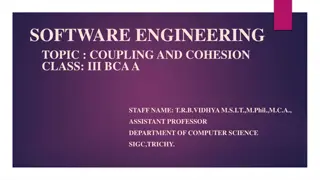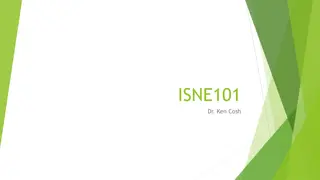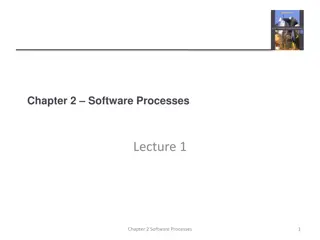Introduction to Software Engineering
Software engineering encompasses the development, management, and maintenance of software systems, focusing on high quality, reliability, and efficiency. It involves understanding software vs. hardware, different software categories, legacy software, and the importance of software engineering principles.
Download Presentation

Please find below an Image/Link to download the presentation.
The content on the website is provided AS IS for your information and personal use only. It may not be sold, licensed, or shared on other websites without obtaining consent from the author.If you encounter any issues during the download, it is possible that the publisher has removed the file from their server.
You are allowed to download the files provided on this website for personal or commercial use, subject to the condition that they are used lawfully. All files are the property of their respective owners.
The content on the website is provided AS IS for your information and personal use only. It may not be sold, licensed, or shared on other websites without obtaining consent from the author.
E N D
Presentation Transcript
SE with UML Introduction to Software and Software Engineering Presented By Prof. Bhumi Shah
What is Software? Software is: 1)instructions (computer programs) that when executed provide desired features, function, and performance; 2)data structures that enable the programs to adequately manipulate information and 3)documentation that describes the operation and use of the programs.
Differences between Software and Hardware Software is developed or engineered; it is not manufactured in the classical sense Impacts the management of software projects Software doesn't wear out Hardware bathtub curve compared to the software ascending spiked curve Although the industry is moving toward component-based construction(COTS- Commercial off-the-shelf) , most software continues to be custom built
Software Application Domains system software application software engineering/scientific software embedded software product-line software WebApps (Web applications) AI software
SoftwareNew Categories 6 Open world computing pervasive, distributed computing Ubiquitous computing wireless networks Netsourcing the Web as a computing engine Open source free source code open to the computing community
Legacy Software 7 Why must it change? software must be adapted to meet the needs of new computing environments or technology. software must be enhanced to implement new business requirements. software must be extended to make it interoperable with other more modern systems or databases. software must be re-architected to make it viable within a network environment.
Software Engineering Some realities: a concerted effort should be made to understand the problem before a software solution is developed design becomes a pivotal activity software should exhibit high quality software should be maintainable The seminal definition: [Software engineering is] the establishment and use of sound engineering principles in order to obtain economically software that is reliable and works efficiently on real machines.
Software Engineering 9 The IEEE definition: Software Engineering: The application of a systematic, disciplined, quantifiable approach to the development, operation, and maintenance of software; that is, the application of engineering to software.
Software Myths - Management "We already have a book that is full of standards and procedures for building software. Won't that provide my people with everything they need to know?" Not used, not up to date, not complete, not focused on quality, time, and money "If we get behind, we can add more programmers and catch up" Adding people to a late software project makes it later Training time, increased communication lines "If I decide to outsource the software project to a third party, I can just relax and let that firm build it" Software projects need to be controlled and managed
Software Myths - Customer "A general statement of objectives is sufficient to begin writing programs we can fill in the details later" Ambiguous statement of objectives spells disaster "Project requirements continually change, but change can be easily accommodated because software is flexible" Impact of change depends on where and when it occurs in the software life cycle (requirements analysis, design, code, test)
Software Myths - Practitioner "Once we write the program and get it to work, our job is done" 60% to 80% of all effort expended on software occurs after it is delivered "Until I get the program running, I have no way of assessing its quality Formal technical reviews of requirements analysis documents, design documents, and source code (more effective than actual testing) "The only deliverable work product for a successful project is the working program" Software, documentation, test drivers, test results "Software engineering will make us create voluminous and unnecessary documentation and will invariably slow us down" Creates quality, not documents; quality reduces rework and provides software on time and within the budget
The Software Process - - - - - A layered technology Process, methods, and tools Generic process framework Umbrella activities
Software Engineering is a Layered Technology Tools Methods Processes Quality Focus
Process, Methods, and Tools Process Provides the glue that holds the layers together; enables rational and timely development; provides a framework for effective delivery of technology; forms the basis for management; provides the context for technical methods, work products, milestones, quality measures, and change management Methods Provide the technical "how to" for building software; rely on a set of basic principles; encompass a broad array of tasks; include modeling activities Tools Provide automated or semi-automated support for the process and methods (i.e., CASE tools)
Generic Process Framework Communication Involves communication among the customer and other stake holders; encompasses requirements gathering Planning Establishes a plan for software engineering work; addresses technical tasks, resources, work products, and work schedule Modeling (Analyze, Design) Encompasses the creation of models to better understand the requirements and the design Construction (Code, Test) Combines code generation and testing to uncover errors Deployment Involves delivery of software to the customer for evaluation and feedback
Umbrella Activities Umbrella activities are applied throughout a software project and help a software team manage and control progress, qual_x005F_x0002_ity, change, and risk. Software requirements management Software project planning Software project tracking and oversight Software quality assurance Software configuration management Software subcontract management Formal technical reviews Risk management Measurement process, project, product Reusability management (component reuse) Work product preparation and production
What is a Process? (Webster) A system of operations in producing something; a series of actions, changes, or functions that achieve an end or a result (IEEE) A sequence of steps performed for a given purpose
What is a Software Process? A set of activities, methods, practices, and transformations that people use to develop and maintain software and the associated products (e.g., project plans, design documents, code, test cases, and user manuals) As an organization matures, the software process becomes better defined and more consistently implemented throughout the organization Software process maturity is the extent to which a specific process is explicitly defined, managed, measured, controlled, and effective
SDLC-Software Development Life Cycle process to design, develop and test high quality softwares. The SDLC aims to produce a high-quality software that meets or exceeds customer expectations, reaches completion within times and cost estimates.
Prescriptive Process Models - Generic process framework - Traditional process models - Specialized process models - The unified process
Prescriptive Process Model Defines a distinct set of activities, actions, tasks, milestones, and work products that are required to engineer high-quality software The activities may be linear, incremental, or evolutionary 25
Waterfall Model (Diagram) Communication Project initiation Requirements gathering Planning Estimating Scheduling Tracking Modeling Analysis Design Construction Code Test Deployment Delivery Support Feedback 26
Waterfall Model (Description) Oldest software lifecycle model and best understood by upper management Used when requirements are well understood and risk is low Work flow is in a linear (i.e., sequential) fashion Used often with well-defined adaptations or enhancements to current software 27
Waterfall Model (Problems) Doesn't support iteration, so changes can cause confusion Difficult for customers to state all requirements explicitly and up front Requires customer patience because a working version of the program doesn't occur until the final phase Problems can be somewhat alleviated in the model through the addition of feedback loops 28
Waterfall Model with Feedback (Diagram) Communication Project initiation Requirements gathering Planning Estimating Scheduling Tracking Modeling Analysis Design Construction Code Test Deployment Delivery Support Feedback 29
Incremental Model (Diagram) Increment #1 Communication Planning Modeling Construction Deployment Increment #2 Communication Planning Modeling Construction Deployment Increment #3 Communication Planning Modeling Construction Deployment 30
Incremental Model (Description) Used when requirements are well understood Multiple independent deliveries are identified Work flow is in a linear (i.e., sequential) fashion within an increment and is staggered between increments Iterative in nature; focuses on an operational product with each increment Provides a needed set of functionality sooner while delivering optional components later Useful also when staffing is too short for a full-scale development 31
Prototyping Model (Description) Follows an evolutionary and iterative approach Used when requirements are not well understood Serves as a mechanism for identifying software requirements Focuses on those aspects of the software that are visible to the customer/user Feedback is used to refine the prototype 32
Prototyping Model (Diagram) Quick Planning Communication Start Modeling Quick Design Deployment, Delivery, and Feedback Construction Of Prototype 33
Prototyping Model (Potential Problems) The customer sees a "working version" of the software, wants to stop all development and then buy the prototype after a "few fixes" are made Developers often make implementation compromises to get the software running quickly (e.g., language choice, user interface, operating system choice, inefficient algorithms) Lesson learned Define the rules up front on the final disposition of the prototype before it is built In most circumstances, plan to discard the prototype and engineer the actual production software with a goal toward quality 34
1. Advantages of Prototype model: Users are actively involved in the development Since in this methodology a working model of the system is provided, the users get a better understanding of the system being developed. Errors can be detected much earlier. Quicker user feedback is available leading to better solutions. Missing functionality can be identified easily.
2. Disadvantages of Prototype model: Leads to implementing and then repairing way of building systems. Practically, this methodology may increase the complexity of the system as scope of the system may expand beyond original plans. Incomplete application may cause application not to be used as the full system was designed. Incomplete or inadequate problem analysis.
The RAD Model It is Rapid Application Development Model. It is a type of incremental model. In RAD model the components or functions are developed in parallel as if they were mini projects. The developments are time boxed, delivered and then assembled into a working prototype. It quickly gives the customer something to see and use and to provide feedback regarding the delivery and their requirements. It is a faster development process
1.Business Modelling The business model for the product under development is designed in terms of flow of information and the distribution of information between various business channels. A complete business analysis is performed to find the vital information for business, how it can be obtained, how and when is the information processed and what are the factors driving successful flow of information.
2) Data Modelling The information gathered in the Business Modelling phase is reviewed and analyzed to form sets of data objects vital for the business. The attributes of all data sets is identified and defined. The relation between these data objects are established and defined in detail in relevance to the business model.
3) Process Modelling The data object sets defined in the Data Modelling phase are converted to establish the business information flow needed to achieve specific business objectives as per the business model. The process model for any changes or enhancements to the data object sets is defined in this phase. Process descriptions for adding, deleting, retrieving or modifying a data object are given.
4) Application generation Automated tools are used to convert process models into code and the actual system.
Testing and Turnover The overall testing time is reduced in the RAD model as the prototypes are independently tested during every iteration. The data flow and the interfaces between all the components need to be thoroughly tested with complete test coverage. Since most of the programming components have already been tested, it reduces the risk of any major issues.
Advantages of RAD Model Reduces the development time Increases the reusability of components Faster deliver time Simple and better quality Great customer satisfaction
Disadvantages of RAD Model Required highly skilled designer Can t use for small project When technical risk is high this model is not appropriate.
Spiral Model (Description) Invented by Dr. Barry Boehm in 1988 while working at TRW Follows an evolutionary approach Used when requirements are not well understood and risks are high Inner spirals focus on identifying software requirements and project risks; may also incorporate prototyping Outer spirals take on a classical waterfall approach after requirements have been defined, but permit iterative growth of the software Operates as a risk-driven model a go/no-go decision occurs after each complete spiral in order to react to risk determinations Requires considerable expertise in risk assessment Serves as a realistic model for large-scale software development 46
Spiral Model (Diagram) Planning Communication Modeling Start Start Deployment Construction 47
General Weaknesses of Evolutionary Process Models 1) Prototyping poses a problem to project planning because of the uncertain number of iterations required to construct the product Evolutionary software processes do not establish the maximum speed of the evolution If too fast, the process will fall into chaos If too slow, productivity could be affected Software processes should focus first on flexibility and extensibility, and second on high quality We should prioritize the speed of the development over zero defects Extending the development in order to reach higher quality could result in late delivery 2) 3) 48
Component-based Development Model Component based development is an approach to software development that focuses on the design and development of reusable components. Consists of the following process steps Available component-based products are researched and evaluated for the application domain in question Component integration issues are considered A software architecture is designed to accommodate the components Components are integrated into the architecture Comprehensive testing is conducted to ensure proper functionality Relies on a robust component library Capitalizes on software reuse, which leads to documented savings in project cost and time 49
What is Agility? Effective (rapid and adaptive) response to change (team members, new technology, requirements) Effective communication in structure and attitudes among all team members, technological and business people, software engineers and managers Drawing the customer into the team. Eliminate us and them attitude. Planning in an uncertain world has its limits and plan must be flexible. Organizing a team so that it is in control of the work performed Emphasize an incremental delivery strategy as opposed to intermediate products that gets working software to the customer as rapidly as feasible.
